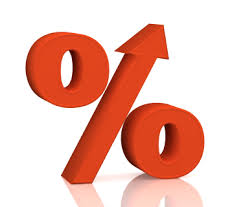What Effects Will Higher Interest Rates Have In Agriculture?
 As we roll into 2014, farmers and landowners are looking ahead to see what the new year will mean for commodity prices and land values. One of the main indicators affecting these prices is the interest rate. Producers wonder whether they will see an increase in interest rates in 2014, and if so, how that will ultimately affect their farming operations.
As we roll into 2014, farmers and landowners are looking ahead to see what the new year will mean for commodity prices and land values. One of the main indicators affecting these prices is the interest rate. Producers wonder whether they will see an increase in interest rates in 2014, and if so, how that will ultimately affect their farming operations.
After nearly a decade of burgeoning land values resulting from high commodity prices combined with extremely low interest rates, 2013 and 2014 might bring about a market correction in this area, and it seems as if the value of farmland has peaked for the time being. The first half of 2013 saw slight increases in the interest rate, along with falling commodity prices. As a result, land values seem to be leveling off.
In a report entitled, “Land Values Peaking Out—But Not Down,” Sterling Liddell, a senior analyst at Rabobank Food & Agribusiness Research and Advisory (FAR), predicts that while commodity prices will likely be lower in the coming year, they won’t be low enough for long enough to substantially affect land values in the short term.
However, Liddell also notes that the greatest risk to land values is higher interest rates. Since interest rates can hardly go any lower than they have been in recent years, it’s a widely accepted assertion that they will inevitably rise. When might this increase take place? Based on current Federal Reserve Policy, substantial increases aren’t forecasted until later 2014 into 2015. According to analysts at the web-based Farmland Investor Center, “More specifically, the Fed has said that it will hold short-term interest rates near zero as long as the unemployment rate remains above 6.5% and inflation expectations one to two years out remain under 2.5%. The Fed projects the unemployment rate could fall to 6.5% in 2014. But most Fed officials expect to hold off on a rate increase until 2015, according to an internal assessment of monetary policy.”
While it’s widely known that higher interest rates negatively affect land value, what’s less known is to what degree. Jeff Caldwell of Agriculture.com postures that land values are likelier to respond more sharply to interest rate increases in the current market climate, since a market indicator known as the capitalized value of land is so high. “The higher the capitalized value, the more the land is being influenced by factors like low interest rates, thereby making it more susceptible to value declines when those factors change.” Thus, Caldwell posits that a rise in interest rates would affect land values more quickly and more sharply now than it might when the capitalized land value is lower.
In the meantime, no matter when or to what degree interest rates increase, it’s more important than ever for farmers and landowners to keep a close eye on their input costs and marketing as they’re faced with the likelihood of land value decreases and interest rate increases in the foreseeable future.
If you would like to evaluate your options as a land owner, contact a UFARM professional land manager. Consultations are free.
Sources: “Falling Land Values? Watch Interest Rates.” Web log post. Agriculture.com. Caldwell, Jeff. 27 Aug. 2012. Web. 02 Jan. 2014.
“Era of Record Low Mortgage Rates Ending as Fed Begins Paring Back Bond Purchases.” Web log post. Farmland Investor Center. N.p., n.d. Web. 02 Jan. 2014.

